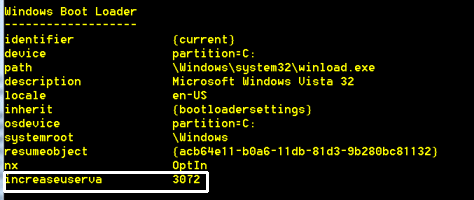
On Microsoft® Windows ServerTM 2003 and Windows® XP Professional SP2, ThinkDesign is able to address up to 2 GB of memory address space, with some of the memory being physical memory and some being virtual memory. Another 2 GB are reserved to Windows.
When ThinkDesign requires a large amount of RAM, such as when handling large assemblies, the paging process increases dramatically and performance may be negatively impacted.
On 32-bit versions of these operating systems (no such limitations on 64 bit systems), the "/3GB" parameter enables you to tune the RAM in order to enlarge the user-mode virtual address space to 3GB and restrict the kernel-mode components to the remaining 1GB. By setting the "/3GB" switch in the Boot.ini file on computers with at least 2 GB of physical RAM installed, in fact, ThinkDesign is more likely to be able to have more of its memory remain in physical memory rather than be paged out. This increases the performance of ThinkDesign that is capable of exploiting the "/3GB" switch.
For more information, see A Description of the 4 GB RAM Tuning Feature and the Physical Address Extension Switch in the Microsoft® Knowledge Base.
| Warning The "/3GB" option may cause system instability with some hardware configuration (mainly high performance graphics cards). If this is the case, add the "/userva=2900" option in order to limit the memory available to the application to 2.9GB and allow enough memory to the graphics card. Although the "2900" value works in most cases, you may have to lower it by successive approximations (2800, 2700 and so on) based on your system configuration. For more information, see How to use the /userva switch with the /3GB switch to tune the User-mode space to a value between 2 GB and 3 GB in the Microsoft® Knowledge Base. |
If your operating system is Windows® VistaTM (32 bit systems only — no such limitations on 64 bit systems) you can increase your virtual memory space for a single application as follows.
You can check the obtained result by simply typing BCDEdit and hitting ENTER. You should get something like the following:

The increaseuserva variable specifies the amount of memory, in megabytes, for user-mode virtual address space. This variable can have any value between 2048 (2 GB) and 3072 (3 GB) megabytes in decimal notation. Windows uses the remaining address space (4 GB minus the specified amount) as its kernel-mode address space.
For further details, see the MSDN knowledge base:
ThinkDesign supports the advanced motion controllers by 3Dconnexion, a Logitech Company. The controllers deliver a unique and powerful two-handed work style to ThinkDesign: users can pan, zoom and rotate with a controller in one hand while they simultaneously create, edit or annotate with a traditional mouse.
The software necessary to interface such devices is installed with ThinkDesign, and the user is only required to configure the device type and other options in the 3D Input Devices category of the Options/Properties.
Please note:
|
(*) An Elevated Command Prompt is a command prompt obtained as follows: